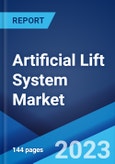The global artificial lift system market size reached US$ 22.0 Billion in 2022. Looking forward, the publisher expects the market to reach US$ 30.5 Billion by 2028, exhibiting a growth rate (CAGR) of 5.4% during 2023-2028.
An artificial lift system refers to a mechanical lifting method used to lower the producing bottomhole pressure (BHP) on the development to increase the production rate from the well. Hydraulic lift, progressive cavity pump (PCP), rod lift, electric submersible pump (ESP), plunger lift, and gas lift are some of the common types of artificial lift systems. Consisting of a motor, pump, impellers, blades, controller, and a cable system, an artificial lift system is widely used to generate a higher rate current from a well that is not strong enough to push oil to the surface. Apart from this, these systems are efficient, simple, wireless retrievable, offer a high degree of flexibility, and can handle unfavorable climatic conditions.
An artificial lift system refers to a mechanical lifting method used to lower the producing bottomhole pressure (BHP) on the development to increase the production rate from the well. Hydraulic lift, progressive cavity pump (PCP), rod lift, electric submersible pump (ESP), plunger lift, and gas lift are some of the common types of artificial lift systems. Consisting of a motor, pump, impellers, blades, controller, and a cable system, an artificial lift system is widely used to generate a higher rate current from a well that is not strong enough to push oil to the surface. Apart from this, these systems are efficient, simple, wireless retrievable, offer a high degree of flexibility, and can handle unfavorable climatic conditions.
Artificial Lift System Market Trends:
Significant growth in the oil and gas industry across the globe is creating a positive outlook for the market. In line with this, artificial lift systems are widely used during oil production and exploration activities to increase the pressure within the reservoir and encourage oil to the surface at higher efficiency. Apart from this, various advancements in technologies, such as the integration of artificial intelligence (AI) and the Internet of Things (IoT) to optimize hydrocarbon withdrawal and prevent the incidence of destructive events, are providing a considerable boost to the market growth. Additionally, the increasing demand for ESPs due to their versatile nature and the ability to handle a high volume and a wide range of flow rates while operating efficiently in harsh environmental conditions is augmenting the market growth. Other factors, including the rapid establishment of new exploration fields and the increasing number of onshore and offshore production and exploration activities, are anticipated to drive the market toward growth.Key Market Segmentation:
The publisher provides an analysis of the key trends in each sub-segment of the global artificial lift system market report, along with forecasts at the global, regional and country level from 2023-2028. The report has categorized the market based on lift type, well type, mechanism and application.Breakup by Lift Type:
- Electric Submersible Pumps (ESP)
- Progressing Cavity Pumps (PCP)
- Gas Lift
- Rod Lift
- Hydraulic Pumps
- Others
- Breakup by Well Type:
- Horizontal
- Vertical
Breakup by Mechanism:
- Gas Assisted
- Pump Assisted
Breakup by Application:
- Offshore
- Onshore
Breakup by Region:
- North America
- United States
- Canada
- Asia-Pacific
- China
- Japan
- India
- South Korea
- Australia
- Indonesia
- Others
- Europe
- Germany
- France
- United Kingdom
- Italy
- Spain
- Russia
- Others
- Latin America
- Brazil
- Mexico
- Others
- Middle East and Africa
Competitive Landscape:
The competitive landscape of the industry has also been examined along with the profiles of the key players being Baker Hughes Company, Borets International Ltd., Canadian Advanced ESP Inc., ChampionX, Dover Corporation, General Electric Company, Halliburton Company, JJ Tech, NOV Inc., Schlumberger Limited, Tenaris S.A. (Techint) and Weatherford International plc.Key Questions Answered in This Report:
- How has the global artificial lift system market performed so far and how will it perform in the coming years?
- What has been the impact of COVID-19 on the global artificial lift system market?
- What are the key regional markets?
- What is the breakup of the market based on the lift type?
- What is the breakup of the market based on the well type?
- What is the breakup of the market based on the mechanism?
- What is the breakup of the market based on the application?
- What are the various stages in the value chain of the industry?
- What are the key driving factors and challenges in the industry?
- What is the structure of the global artificial lift system market and who are the key players?
- What is the degree of competition in the industry?
Table of Contents
1 Preface3 Executive Summary12 Value Chain Analysis14 Price Analysis
2 Scope and Methodology
4 Introduction
5 Global Artificial Lift System Market
6 Market Breakup by Lift Type
7 Market Breakup by Well Type
8 Market Breakup by Mechanism
9 Market Breakup by Application
10 Market Breakup by Region
11 SWOT Analysis
13 Porters Five Forces Analysis
15 Competitive Landscape
Companies Mentioned
- Baker Hughes Company
- Borets International Ltd.
- Canadian Advanced ESP Inc.
- ChampionX
- Dover Corporation
- General Electric Company
- Halliburton Company
- JJ Tech
- NOV Inc.
- Schlumberger Limited
- Tenaris S.A. (Techint)
- Weatherford International plc.
Methodology

LOADING...
Table Information
| Report Attribute | Details |
|---|---|
| No. of Pages | 144 |
| Published | September 2023 |
| Forecast Period | 2022 - 2028 |
| Estimated Market Value ( USD | $ 22 Billion |
| Forecasted Market Value ( USD | $ 30.5 Billion |
| Compound Annual Growth Rate | 5.6% |
| Regions Covered | Global |
| No. of Companies Mentioned | 12 |









